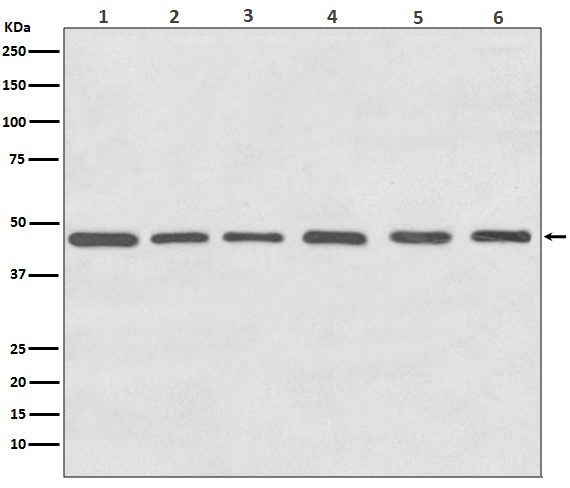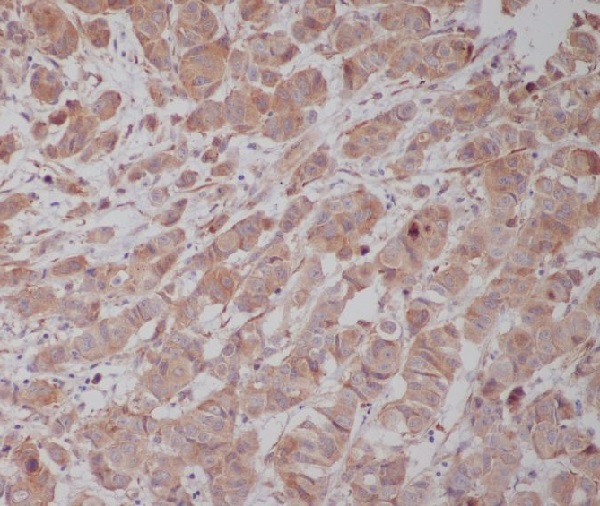

| WB | 1/500-1/1000 | Human,Mouse,Rat,Chicken,Hamster,Cow,Dog,Fish,Xenopus,Tropicalis |
| IF | 1/20 | Human,Mouse,Rat,Chicken,Hamster,Cow,Dog,Fish,Xenopus,Tropicalis |
| IHC | 1/50-1/100 | Human,Mouse,Rat,Chicken,Hamster,Cow,Dog,Fish,Xenopus,Tropicalis |
| ICC | 1/50-1/200 | Human,Mouse,Rat,Chicken,Hamster,Cow,Dog,Fish,Xenopus,Tropicalis |
| FCM | 1/50-1/100 | Human,Mouse,Rat,Chicken,Hamster,Cow,Dog,Fish,Xenopus,Tropicalis |
| Elisa | 咨询技术 | Human,Mouse,Rat,Chicken,Hamster,Cow,Dog,Fish,Xenopus,Tropicalis |
| Aliases | TUBG1; TUBG; Tubulin gamma-1 chain; Gamma-1-tubulin; Gamma-tubulin complex component 1; GCP-1 |
| Entrez GeneID | 7283 |
| WB Predicted band size | Calculated MW: 51 kDa; Observed MW: 48 kDa |
| Host/Isotype | Rabbit IgG |
| Antibody Type | Primary antibody |
| Storage | Store at 4°C short term. Aliquot and store at -20°C long term. Avoid freeze/thaw cycles. |
| Species Reactivity | Human,Mouse,Rat,Monkey,Chicken,Hamster,Cow,Dog,Fish,Xenopus,Tropicalis |
| Immunogen | A synthesized peptide derived from human Tubulin gamma |
| Formulation | Purified antibody in PBS with 0.05% sodium azide. |
+ +
以下是3篇关于γ-Tubulin抗体的参考文献及其摘要概括:
1. **"γ-Tubulin is a highly conserved component of the centrosome"**
*作者:Joshi, H. C., Palacios, M. J., McNamara, L., & Cleveland, D. W. (1992)*
**摘要**:该研究通过制备并验证特异性抗γ-Tubulin抗体,发现γ-Tubulin广泛存在于多种物种的细胞中,并集中于中心体区域。抗体通过免疫荧光和免疫印迹证实其特异性,为后续研究微管成核机制提供了工具。
2. **"Cloning and characterization of γ-tubulin cDNA from a human T-cell line"**
*作者:Stearns, T., Evans, L., & Kirschner, M. (1991)*
**摘要**:研究首次克隆了人类γ-Tubulin基因,并利用重组蛋白制备抗体。抗体在哺乳动物细胞中验证了γ-Tubulin在中心体的定位,揭示了其在微管组装中的核心作用,为研究细胞分裂异常提供了分子工具。
3. **"Drosophila γ-tubulin is required for the formation of pole microtubule fibers and spindle asymmetry"**
*作者:Julian, M., Tollon, Y., Lajoie-Mazenc, I., & Wright, M. (1993)*
**摘要**:通过果蝇模型制备的γ-Tubulin抗体,证明其在纺锤体极部微管纤维形成中的必要性。抗体实验显示γ-Tubulin缺失导致纺锤体对称性异常,支持了其在细胞分裂中的调控功能。
4. **"Microtubule nucleation by γ-tubulin-containing complexes in different organisms"**
*作者:Luders, J., & Stearns, T. (2007)*
**摘要**:综述性文章总结了γ-Tubulin抗体在酵母、动物细胞等模型中的应用,强调抗体如何帮助解析不同物种中γ-Tubulin复合物(如γ-TuRC)的保守性及微管成核机制。
这些文献涵盖了抗体的开发、验证及其在细胞生物学研究中的应用方向(如中心体功能、微管组装和细胞分裂)。
Gamma tubulin, a crucial member of the tubulin protein family, plays a pivotal role in microtubule nucleation and organization. Unlike alpha- and beta-tubulins, which form microtubule polymers, gamma-tubulin primarily localizes to microtubule-organizing centers (MTOCs), such as centrosomes, where it initiates microtubule assembly. This protein is essential for mitotic spindle formation, cell division, and maintaining cytoskeletal architecture. Its conserved structure includes a core GTP-binding domain, but unlike other tubulins, it lacks polymerization capacity, instead serving as a template for microtubule growth.
Gamma tubulin antibodies are vital tools in cell biology research, enabling the detection and visualization of gamma-tubulin in cellular structures. These antibodies are widely used in techniques like immunofluorescence, Western blotting, and immunohistochemistry to study centrosome dynamics, mitotic mechanisms, and cell cycle regulation. Specific clones (e.g., GTU-88) are validated for distinguishing gamma-tubulin from other tubulin isoforms. Researchers also employ these antibodies to investigate centrosome abnormalities linked to diseases, including cancer and neurodevelopmental disorders. Cross-reactivity with gamma-tubulin orthologs makes them applicable in diverse model organisms. Optimal usage requires attention to fixation methods (e.g., methanol fixation preserves epitopes) and tissue-specific antigen retrieval. As microtubule-targeting drugs gain prominence in oncology, gamma-tubulin antibodies remain critical for elucidating cytoskeletal dysfunction in therapeutic contexts.
×